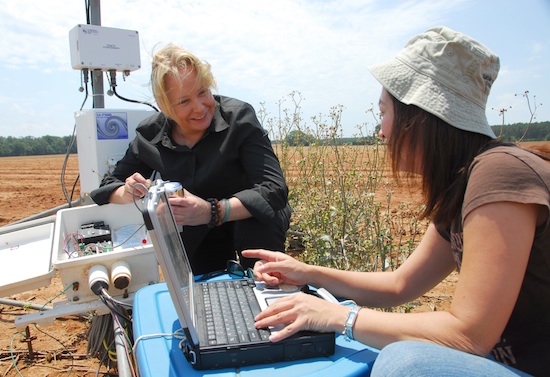Some landscapes — like forests — are known for keeping carbon dioxide out of the atmosphere. Others shed carbon dioxide or other gasses that can affect the environment.
Calculating just how much of each gas is held or released can be difficult but University of Georgia scientist Monique Leclerc has literally written the book on the subject.
Leclerc has pioneered the use of a formula known as eddy covariance or eddy-correlation to measure evapotranspiration, ozone deposition and agricultural impacts — like how much methane cows emit. Leclerc recently released a book on how to use these formulas most effectively.
Teaches how to interpret data
Co-authored by Thomas Foken, Leclerc’s book, Footprints in Micrometeorology and Ecology, is the first textbook on the subject and covers how to interpret meteorological measurements made at a given level over a surface with regard to characteristic properties such as roughness, albedo, heat, moisture, carbon dioxide and other gases.
“Every year, thousands and thousands of scientists across the world use the eddy covariance method to measure how many pesticides are released from a field, how much water is lost from irrigation to the air and how much CO2, nitro oxide and methane are released by cattle, over applications of animal waste and over rice patties,” said Leclerc, a UGA Regents Professor with the UGA College of Agricultural and Environmental Sciences.
The textbook includes chapters for professionals in various fields, including agriculture. “Farmers want to know the true nitrous oxide emissions emitted from fertilizer applications, or their methane losses from manure piles or the optimum amount of irrigated water needed to water their crop given a set of environmental conditions in a particular year,” she said.
Practical uses for farmers
But how can farmers use this data?
“They can determine how much methane their cows are emitting and adjust their diets to change that amount. They can also determine whether gases are coming from their cows or another farmer’s cows,” Leclerc said.
For her research at UGA, Leclerc has field studies across the state, the nation and the world. In Georgia, she has sites on the UGA campus in Griffin, in Plains, Ft. Valley and at the UGA Marine Institute on Sapelo Island. “We take measurements every where from peach orchards in Hollonville to the salt marshes near the Georgia coast,” she said.
The National Science Foundation Long-Term Ecological Research project paired Leclerc with the UGA Marine Institute. This project focuses on sea levels and how they related to carbon balance.
Continual measurements
She and her team take measurements of gases, like carbon dioxide, heat, evaporation and energy, “continuously 24 hours a day, 7 days a week, 10 measurements per second,” she said. “In the same spot, we also collect wind data at the same very high rate. Then we take all that data to the lab and analyze it to come up with a footprint analysis given the vegetation type, mean windspeed, sky conditions and other related variables. Our job in this project is to determine how much carbon is taken up by the vegetation.”
Leclerc explains that rivers carry carbon into oceans and plants remove CO2 from the atmosphere. “Aquatic plants are in and under the water when the tide is high and then they come out of the water. There are a lot of changes over a 24-hour period. Our job is to determine how much carbon is taken up,” she said.
Leclerc has also worked with the U.S. Department of Energy at the Savannah River National Laboratory near Akins, S.C. There she took measurements over corn fields and peanut fields, and broken mixed forests.
A world-renowned expert in the field of agricultural and forest meteorology, Leclerc serves on several advisory panels to the international scientific community. She wrote the newly published book after being approached by researchers like McGill University scientist Peter Schuepp who needed help interpret aircraft data taken over an island in Lake Superior.
Using isn't the same as understanding
“Scientists have switched to this measurement method and they use it, but they always ask me if they are getting a true measurement of the atmosphere over the field or over the neighbor’s house. And, if the plants had drought or insect damage, we know right away,” she said.
Leclerc says instruments record differently on cloudy day than on stormy or sunny days. And respiration measurements over forests are different than measurements over wheat fields. “It’s important to know how much gas is going up from the surface, soil and plants and coming down from the atmosphere,” she said.
In the textbook, Leclerc and Foken provide scientists with guidelines for how to interpret the eddy-covariance data. “We also included theories to empower people so they can use the methods in the book on their own,” she said. “There are weaknesses and strengths of this method and we are very candid with our advice.”
Leclerc equates environmental meteorology work to a puzzle. “In the puzzle you have many pieces. I am just one piece, but my piece is the missing link,” she said.
Footprints in Micrometeorology and Ecology book can be ordered at http://link.springer.com/.








